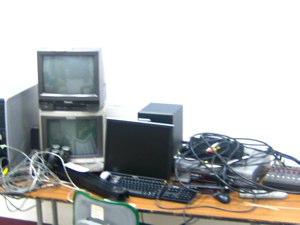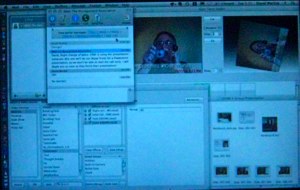I just uploaded my K12 Online presentation, just in under the wire. I’d read the guidelines a while back, and remembered the limit being 40 minutes. So my presentation video was 38 minutes long. Then, re-reading the guidelines this morning, I discovered yet more evidence of my faulty recollection cells, limit is 20 minutes. So I cut it back, and uploaded. The original (director’s cut) version will likely be made available at some point after the K12 Online Conference.
I’m now at the airport, sitting in an American Airlines gate, and they’ve just announced an oversold situation. $300 voucher for anyone who’ll fly to Chicago, by way of Washington, three hours from now. Often, I’ll take them up on it, but not today. I’ve already made first class. Gotta love Platinum and all those other heavy metals.
 |
|
|
One of my stops last week was Sidney, New York, about forty minutes up the river from Binghamton. I was impressed with the school, especially its interest in multimedia as part of the high school’s curriculum. Their tech director, Mike Dionne, told the story of a local corporation, who invested a million plus dollars for studio equipment for their corporate communications, professional development production, and other multimedia work — a couple of rooms worth of stuff. It was not many years before the equipment was obsolete, so the high school got it for free.
Mike pointed out to me, what was left, and that his students are now doing the same work with software installed on standard computers.
By contrast, the video I just uploaded to the K12 Online Conference (which includes some machinima), and the virtual workshop I did last week for a school in Wisconsin, was all done from my laptop, using software that was either free or pre-installed on my computer.
 |
|
|
Many of our students are playing with these tool, creating their own videos and machinimas, doing it for fun, and earning audience. This increasingly ubiquitous access to multimedia production technology makes me wonder what affect it has on basic communication skills for the future — literacy.
I see the pressures to expand our notions of basic communication skills coming from two directions. First, there is the challenge of gaining your audience’s attention. We’re overwhelmed by information, having to choose from a bewildering array of sources, all competing for our attention. It means that communication must now utilize combinations of text, images, sound, video, and animation, arranged appropriately for an audience, in order to accomplish your goal.
But from the other direction, we find ourselves with amazingly sophisticated tools: video cameras costing less than a hundred dollars, software that comes pre-installed on our computers, free software and web services that can turn our standard computers into world-reaching broadcast stations, and a growing virtual world that can be turned into a movie set.
Again, what impact might this have on basic communication skills? What skills are our students already practicing, and what new avenues of conversation are they defining and bringing with them into their future? There is, of course, no simple answer. I personally doubt that creating a list of communication competencies would serve us well. The best thing we can do is to open up as many avenues of connection and conversation as we can — to give our students opportunity, support, and encouragement to develop their communication skills by communicating richly and authentically.

I totally agree that the best thing we can do with ever changing and improving technology is to stay updated ourselves so that we can teach our students as best we can. Communicating is a vital part of educating youth, and if it is done technologically, that is what we will have to teach.